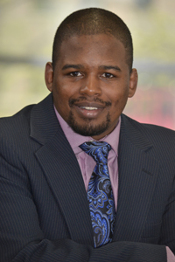UW Law School student Brandon Tillman founded Madison Memorial Mentors to teach high school students about conflict resolution.
Tillman uses the circle process he learned as a student in the Law School’s Restorative Justice Project to build community among freshmen and sophomore boys at Madison Memorial High School. “We create a safe space in the circle to talk about things that won’t come up in a normal high school atmosphere,” he says.

Brandon Tillman
Using restorative justice methods, Tillman coaches the boys to frame conflict differently. Instead of thinking of conflict as a fight between two people, he encourages the youth to think of it as an interaction in which two people address the things that have insulted them.
“We talk about everyday conflicts and how you can analyze them,” Tillman says. “We explore the types of conflicts that a group of minority kids may experience. Kids learn, for instance, how to react when racial slurs are thrown at them.”
Tillman uses music, skits, and even bubbles to keep students active and engaged. The bubbles show kids how managing their breathing can dispel tension.
Restorative justice presents an alternative to the more punitive approaches of the traditional criminal justice system. According to Jonathan Scharrer, who directs the Restorative Justice Project, restorative practices create a safe space for dialogue between victims and offenders and focus on the needs of the victim. The dialogue allows both parties to understand each other better, while building a greater sense of community, he says.
“The more community you build, the less likely you are to have incidences of bullying,” Scharrer says. “When we see each other more as people, and really understand each other, we’re able to build empathy. Often the climate in a classroom — and sometimes even in an entire school — is transformed.”
In addition to the community building activities, Tillman pairs each child with a law student mentor from the Black Law Students Association at UW Law.
He says that when he introduced the mentoring piece of the program, students were impressed: “One of the kids was like, ‘Wait, I’m going to have my own law student?’ and I was like, ‘Yep, just for you.’ They immediately embraced the idea and realized this is something different.”
According to Tillman, the mentoring relationships continued to grow throughout the year. After one student told his mentor he was failing his classes, the pair set up appointments with the student’s teachers and developed a plan to get the child back on track.
“I think that’s powerful, just seeing someone cares, that someone is willing to go the extra step and create solutions where the students might have otherwise given up,” he says.
Restorative justice practices are being implemented throughout the Madison Metropolitan School District. And recently, Dane County launched the Community Restorative Court pilot for 17 to 25 year-olds charged with certain misdemeanor offenses. The City of Madison launched its own program for youths 12 to 16 years old for all municipal citations.
Tillman says he’s glad his program will continue after he graduates from UW Law this summer. The Restorative Justice Project and the Black Law Students Association have plans to keep it going.
— Carly Schesel, schesel@wisc.edu
Submitted by Law School News on January 3, 2017
This article appears in the categories: Articles